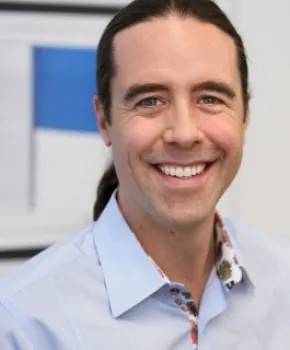
Upcoming 'AI and the Future of Work Symposium' to explore transformative impact of artificial intelligence on industry
As artificial intelligence (AI) continues to revolutionize industries, questions about the future of work have become more pressing than ever. Will AI-powered coworkers become as ubiquitous as email? Will humans compete with-or collaborate alongside-machines?
Weatherhead School of Management at Case Western Reserve University will explore these questions at its inaugural "AI and the Future of Work Symposium" April 24 at the Tinkham Veale University Center.
Matt Beane, a leading researcher on AI in the workplace and author of The Skill Code: How to Save Human Ability in an Age of Intelligent Machines, will be the keynote speaker. He's spent years studying how AI systems transform employee roles across industries.

"AI isn't just about replacing jobs; it's about redefining how we work," said Beane, also an assistant professor of technology management at UC Santa Barbara.
Beane's research explores the balance between automation and human expertise, offering practical insights into how companies can prepare their workforces for AI integration.
Beane's keynote address at CWRU will mirror the structure of his book, he said, unfolding in three acts that delve into the evolving dynamics between humans and intelligent technologies. He identifies a looming multi-trillion-dollar problem: as organizations adopt AI to boost productivity, they often overlook the development of novices, leading to a potential skills gap.
Beane emphasizes that the key to effective skill development lies in embracing what he calls "three C's"-challenge, complexity and connection.
The companies that will best positioned for success, he said, are those "that embrace collaboration between humans and AI…The answer to that question was obvious four to five years ago."
The symposium
In addition to Beane's address, the symposium features speakers Shivang Desai and Chandralika Hazarika, co-founders of Bigthinx, an AI-driven fashion and gaming company. Their insights will focus on AI's influence in creative industries and e-commerce.
The event also includes what organizers are calling "flash talks," practical eight-to-10-minute presentations designed to offer actionable strategies for applying AI in business, healthcare and design. Confirmed speakers include experts serving mid-market businesses, ensuring that the conversation focuses on practical, real-world AI applications.
Attendees will also learn from prominent Weatherhead School faculty, including Youngjin Yoo, associate dean of research; Stefan Agamanolis, associate director of strategic research programs; and Sining Wang, assistant professor of economics. They're all actively researching AI's role in business transformation.
Yoo's research explores AI's influence on scientific publishing, healthcare and open-source platforms. Agamanolis examines how generative AI can enhance creativity in design. Wang's innovative AI4EDU platform is designed to improve student engagement and critical thinking in educational settings.
Shaping industry
"Weatherhead School of Management is committed to leading the conversation on shaping AI's impact in business and society," said Andrew Medvedev, the dean of Weatherhead School of Management. "AI is here. How it gets adopted across the economy will determine the next few decades of our development."
The symposium is designed to appeal to business leaders, investors, entrepreneurs, educators and researchers interested in understanding the practical implications of AI technology. Attendees will walk away with concrete insights on how to harness AI for their organizations. Registration is now open.






